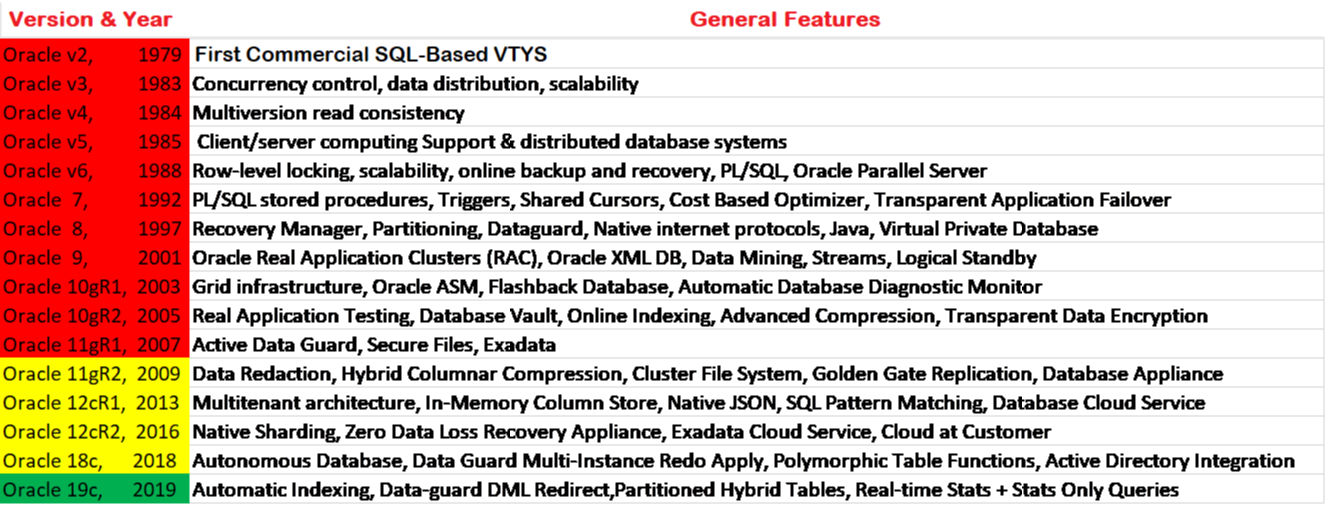Oracle has its roots in the company founded by Larry Ellison, Bob Miner and Ed Oates on June 16, 1977, as Software Development Labs (SDL). Association Software Inc. 3 adventurers who changed their name, Relationship Software Inc. have worked in the province until 1982. The magnificent trio, which consistently focused on database management systems and made their first database trial with IBM, failed in this. In one of the subsequent trials, the template Oracle Republic System led by Bob Miner was a great success. Thereupon, the name Oracle Corporation was changed to Oracle Systems Corporation in 1982. In 1995, it was changed to Oracle Corporation and this name continues to this day.

Oracle 8
This version of RMAN (Recovery Manager), which is the backup and fallback feature of the Oracle database, and the Partitioning feature, which has a great contribution to the database management system especially in terms of performance, came up with this version.
Dataguard feature, which is the disaster recovery feature, was also introduced with Oracle 8.
Oracle 9
The most important feature that we encounter in this version is undoubtedly the Real Application Cluster (RAC) feature. With this feature, Oracle Instance installed on more than one server at the same time provides high availability, which we call High availability of Databases. The VYTS in the top of the list above, which is the rival of Oracle today, still does not have this feature. Especially in customers with instant money flow such as banking and insurance, which we call business-critical systems, RAC feature has become indispensable for corporations.
Oracle 10g
With Oracle 10g, we came across a feature that Oracle, which we call Automatic Storage management feature, can take storage management from operating systems and manage it. The Real application Cluster feature that came with Oracle 9 version was developed and Grid Infrastructure feature came with 10g.
Flashback feature, which is one of the vital features for database administrators and shortens the return on user errors, was also introduced with Oracle 10g.
Advanced Compression and Transparent Data Encryption features are also available with Oracle 10g.
Oracle 11g
With this version, Exadata, which was designed as the database machine that Oracle introduced to the world on the hardware side, appeared. Oracle 11g was the first database version used in Exadata.
Active Dataguard feature for Dataguard databases with disaster recovery feature has emerged in this version and it has been provided to be used in reporting other than disaster purpose.
Data Redaction, Hybrid Columnar Compression and Cluster File System feature is one of the other features we encounter with Oracle 11g.
Oracle 12c
You can find a detailed explanation of Oracle 12c from the link.
Since Oracle 12c brought very different and different features from previous versions, it found a lot of echo in the market and the most important reason was that it brought Cloud logic. Now the concept of g (grid) in 10g and 11g has been replaced by c (cloud).
The most striking features of Oracle 12c are as follows.
- Oracle Multitenant
- Far Sync
- Online Data file migration
- Restore Table from Full Backup
- Invisible Column
- Automatic Data Optimization
- Flex ASM
- Data Masking
- Ability to use more than one index for a column
- Authorization of users at the Container and Pluggable database level.
Oracle18c
Autonomous Database and Data Guard Multi-Instance Redo Apply features are the most important features in this version. Let’s look at what this feature is.
Autonomous Database
Oracle Autonomous Database is a cloud-based technology introduced in 2017, designed to automate many of the routine DBA operations required to manage Oracle databases. Oracle states that this will create an opportunity for database administrators to perform higher and more strategic studies rather than routine and boring tasks. Because Oracle will do a lot of the work of Oracle Database administrators and it will be a self-managed database.
Autonomous Database feature is offered as a cloud service created with artificial intelligence algorithms, which we call machine learning, and with the slogans of “self-driving, self-securing and self-repairing”, self-driving, self-security and self-repair.
Oracle 19c
Oracle Database 19C is the last successor of the 12.2 families and has been launched by the manufacturer as a long-term version. The biggest advantage of Oracle Database 19C was to eliminate chronic problems and solve known problems while developing the product.
Auto Index, Memoptimized Rowstore, Real-Time Statistics and Quarantine SQL Statements have been featured.
Automatic Index: Optimizing database performance without indexes is difficult for many database managers. Oracle Database 19c includes Automatic indexing, which constantly evaluates queries and tables to determine which index to create and which to potentially remove. This runs on an expert system that validates the operations an index can do, and it verifies the assumptions made after it is created. He then uses machine teaching to make sure he doesn’t make the same mistake again.
Memoptimized Rowstore: This feature provides fast data entry to Oracle Database 19c from applications such as the Internet of Things (IoT), which perform small, high-volume transactions with a minimal amount of transactional load. Processes that use the fast input function buffer the data in the large pool temporarily before writing in bulk asynchronously with the journal feature to increase disk performance. In this way, performance is improved.
Real-Time Statistics: Professional query optimizers need to see the data structure and detailed statistics in the tables so that they can make the “most appropriate” decision on how to process complex queries. The problem here is that statistics collection takes a lot of resources and time. For the latest “Always On” applications, it is always difficult to find a tool to carry out batch processing to collect this data. Statistics can be collected in Oracle Database 19c by adding, updating or deleting transactions in real-time.
Quarantine SQL Expressions: Bad SQL statements terminated by Resource Manager can now be quarantined automatically due to excessive consumption of processor and G / Ç resources. It prevents bad SQL statements from being executed again, thus protecting Oracle Database 19c from performance degradation.




